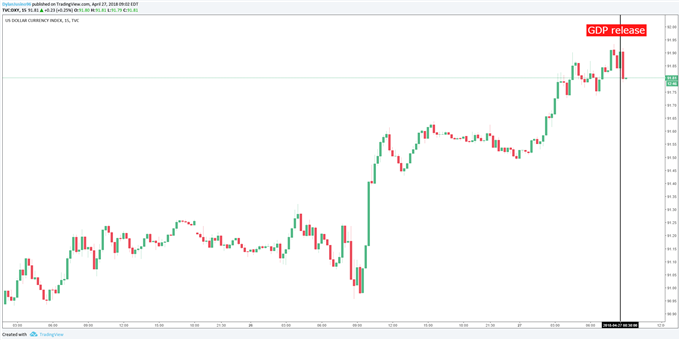
Talking Points:
– The advance estimates for US Gross domestic product came in at 2.3% for 1Q beating the estimated 2.0%
– Tax cuts boosted disposable incomes as well as savings, similarly personal consumption also increased
– Chances of a rate hike in June stand at 93%
– See the DailyFX Economic Calendar for upcoming economic data and for a schedule of live coverage see the DailyFX Webinar Calendar.
Advance Estimate at 2.3%
According to the advance estimate by the Bureau of Economic Analysis (BEA), the US economy grew at a rate of 2.3% in the first quarter which was below the 2.9% growth rate in fourth quarter of 2017. Although, this was significantly above markets’ expectations as 2.0%. Notably, the 2.3% figure released this morning is an “advance” estimate and is subject to change based on revision by the BEA. The actual figure will be released on May30th.
Gross domestic product (GDP) is the headline measure of a country’s economic expansion, or contraction. It is the value of the goods and services produced by the nation’s economy less the value of the goods and services used up in production. GDP is a sum of personal consumption expenditures, gross private domestic investment, net exports of goods and services, and government consumption expenditures and gross investment.
Current-dollar GDP rose by 4.3%, or $211.2 billion, in the first quarter. Although, in the fourth quarter, current-dollar GDP increased 5.3%, or $253.5 billion. The Core personal consumption expenditures price index (PCE), which excludes food and energy prices, increased by 2.5% versus an increase of 1.9% in the previous quarter.
See our longer-term forecasts for the US Dollar, Euro, British Pound and more with the DailyFX Trading Guides
Contributions to the 2.3% Expansion
Today’s increase in real GDP for the first quarter is a reflection of positive contributions from nonresidential fixed investment, personal consumption expenditures (PCE), exports, private inventory investment, federal government spending, and state and local government spending. Although, imports which are a subtracted inthe GDP calculation, increased.
As for the deceleration in real GDP growth in the first quarter, decelerations in PCE, residential fixed
investment, exports, and state and local government spending were contributing factors. Fortunately the slowdowns were partly offset by an increase in private inventory investment. As mentioned before, imports increased, but at a decelerated rate.
And as one would expect, personal current taxes decreased $40.1 billion in the first quarter compared with an increase of $50.1 billion in the previous quarter (before the tax bill went into effect). In part, this increased disposable personal income increased $222.1 billion, or 6.2% percent, comparted to a 3.8% increase in the previous quarter.
Personal saving also rose at $462.1 billion in the Q1 versus $379.8 billion in Q4 of last year. The personal saving rate was at 3.1% in this past quarter, compared to 2.6% previously.
Rate Hike
At the time that this was written Fed Funds Futures price a June rate hike at 93%. While GDP generally does not have a a tremendous impact on FOMC decisions, today’s data certainly does not hurt. GDP tends to have less of an impact on markets given that most of the components that go into the calculation are released ahead of time, such as PCE. Still, a rate hike in June remains well in play, and the primary foreseeable event that could throw that off track is a drop in inflation.
Below is a list of economic releases that has left the dollar unchanged:
– USD Gross Domestic Product (Annualized) (1Q A): 2.3% versus 2.0% expected, from 2.9%
– USD Personal Consumption (1Q A): 1.1% versus 1.1% expected, from 4.0% previous
– USD Gross Domestic Product Price Index (1Q A): 2.0% versus 2.2% expected, from 2.3% previous
– USD Core Personal Consumption Expenditure (QoQ) (1Q A): 2.5% as expected, from 1.9% previous
Chart 1: DXY Index 15-minute Chart (April 25 – 27 2018)

Far more surprising than the data is the lack of a response in the dollar. Traders haven’t taken either side as DXY trades at the same level as before the GDP print. At the time that this was written the DXY traded at 91.81.
— Written by Dylan Jusino, DailyFX Research